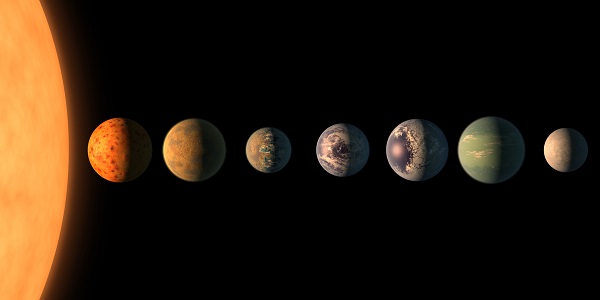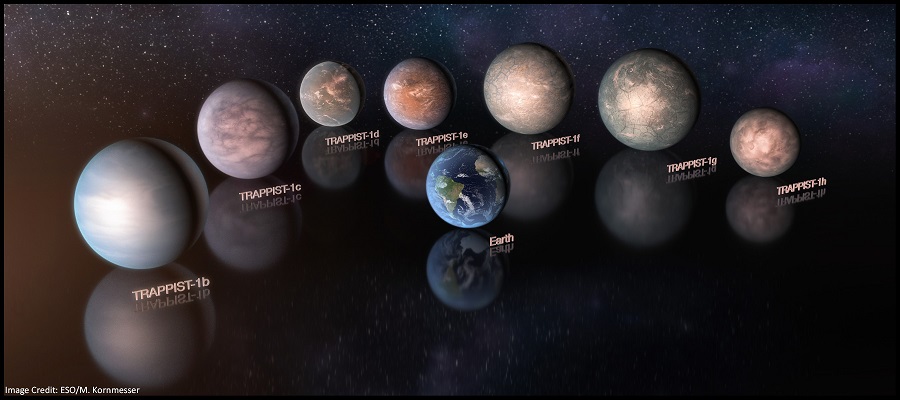Daniel Larsen
A recently completed study, led by UWAB Faculty member Eric Agol and with UWAB Program Director, Victoria Meadows, UWAB Alumni Rodrigo Luger (PhD in Astronomy and Astrobiology, 2016) and Brett Morris (PhD in Astronomy and Astrobiology, 2019), has provided new insights and a greater understanding of the TRAPPIST-1 system and is helping pave the way for future observations of the system with the upcoming James Webb Space Telescope.
Prof. Agol and his team (which included many other collaborators from around the world) spent 4 years making numerous observations of the TRAPPIST-1 system using Spitzer, Hubble and Kepler Space Telescopes, as well as other ground based observatories. During their study they watched the system to observe and measure the dimming of the light received by their telescope each time the planets would transit in front of their parent star. They were able to detect timing differences between successive transits of the planets that showed that gravitational interactions with the other planets in the system were pulling and pushing the planets in their orbits, allowing the planets’ masses to be measured to exquisite precision. Their findings, with fractional precisions down to 1%, improve upon the precision of the prior calculations of the planet’s masses by a factor of several, and compared with the best radial-velocity measurements of the star by up to two orders of magnitude!

With these greatly refined mass and radii measurements, the team was able to calculate accurate densities for each planet and they found that all of the planets have very similar uncompressed densities to each other, but that they all had densities lower than that of Earth. The team suggested several reasons why that might be. One suggestion is that the TRAPPIST-1 planetary cores may be depleted in iron when compared with planets in our own Solar System. Another is that any iron in the planets may be in an oxidized form, and distributed more evenly throughout the planet. Alternatively, the planets could have interior structures similar to the Earth’s with a larger iron core, but have an overall much larger fraction of water. If this is the case, then the 3 inner planets in the system are all too close for water to likely exist on the surface in a liquid state, but the outer 4 planets may have surface oceans, or subsurface oceans beneath a frozen shell. How much surface water could vary quite a bit however. Their analyses showed the ratio of surface water to the mass of the planets could range from much less (0.001%) than Earth’s 0.05%, to much more (5%) in order to match the data..

Understanding the orbital properties of the planets was especially important for refining the characteristics of the planet and for planning future, detailed, observations. This study, lasting a little more than 4 years, is the first and only study so far to span twice the full ~1.3 year resonant period of the system of planets and thus was able to conduct the most thorough and accurate analyses and greatly improve upon the existing mass estimates.
While there have been over 4000 exoplanets discovered to date the planets in the TRAPPIST-1 system are some of the most Earth-like ones found yet. The system, which has 7 small, rocky, planets with 3 of them located in the star’s habitable zone, is one of the most likely places we’ve found yet to search for signs of life outside of our solar system and also provides astronomers with an outstanding laboratory for conducting comparative planetology.
What makes a planet habitable is a very complicated idea that is not well understood, but it is likely dependent upon a large number of factors such as the location of planet’s orbit around its star, the abundance of various elements on the planet, and the presence of liquid water. What we do know is that there is a strong interplay between the interiors, surfaces, and atmospheres of planets and properly understanding these processes will require accurate measurements of a planet’s fundamental properties like mass and radius, which have been greatly improved upon by the work of Eric Agol and his colleagues.

The article has been published as open access in the Planetary Sciences Journal and you can read a copy of it here. It has also been covered in a number of other news outlets including the following:

